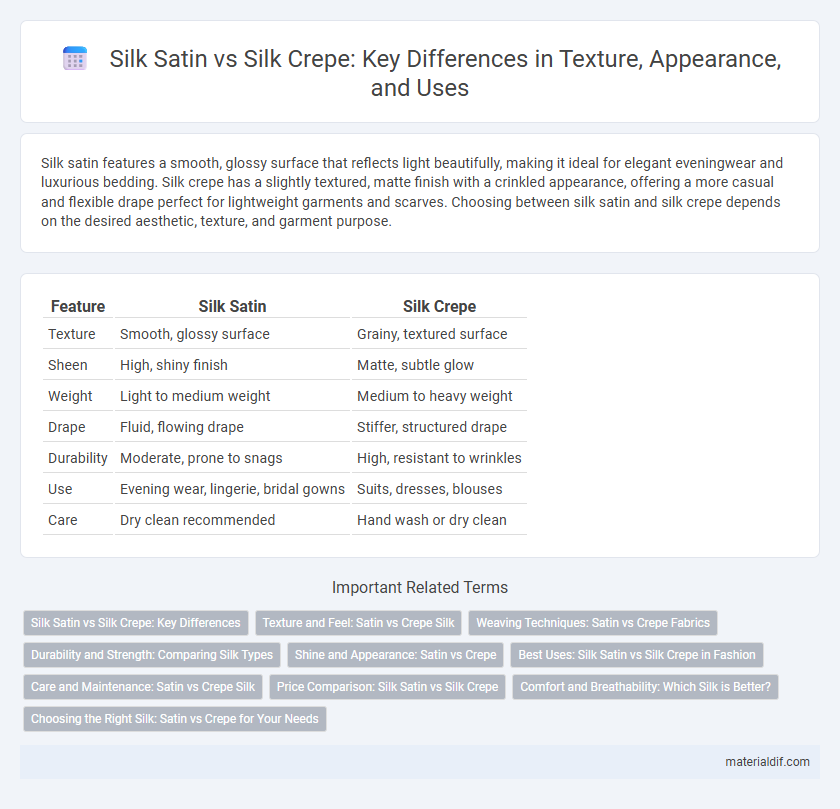Silk satin features a smooth, glossy surface that reflects light beautifully, making it ideal for elegant eveningwear and luxurious bedding. Silk crepe has a slightly textured, matte finish with a crinkled appearance, offering a more casual and flexible drape perfect for lightweight garments and scarves. Choosing between silk satin and silk crepe depends on the desired aesthetic, texture, and garment purpose.
Table of Comparison
| Feature | Silk Satin | Silk Crepe |
|---|---|---|
| Texture | Smooth, glossy surface | Grainy, textured surface |
| Sheen | High, shiny finish | Matte, subtle glow |
| Weight | Light to medium weight | Medium to heavy weight |
| Drape | Fluid, flowing drape | Stiffer, structured drape |
| Durability | Moderate, prone to snags | High, resistant to wrinkles |
| Use | Evening wear, lingerie, bridal gowns | Suits, dresses, blouses |
| Care | Dry clean recommended | Hand wash or dry clean |
Silk Satin vs Silk Crepe: Key Differences
Silk satin is known for its glossy, smooth surface and luxurious drape, making it ideal for eveningwear and lingerie, while silk crepe features a matte, textured finish with a slightly crinkled appearance that provides more structure and durability, suited for blouses and suits. The weave of silk satin uses a four-over, one-under pattern that creates its characteristic sheen, whereas silk crepe employs a tighter, twisted weave resulting in its grainy texture. Weight and breathability also differ, with silk satin being lighter and more breathable compared to the heavier, more opaque silk crepe.
Texture and Feel: Satin vs Crepe Silk
Silk satin features a smooth, glossy surface with a sleek, luxurious feel that drapes elegantly and reflects light beautifully. In contrast, silk crepe has a textured, matte finish with a slightly crinkled appearance, offering a soft, grainy feel and a more structured drape. The distinct textures impact their tactile experience, making satin ideal for formal wear and crepe favored for garments requiring subtle texture and body.
Weaving Techniques: Satin vs Crepe Fabrics
Silk satin is characterized by a weaving technique that produces a smooth, glossy surface with a lustrous sheen, achieved through floating warp yarns over weft yarns to create a distinct shine. In contrast, silk crepe utilizes a weaving method involving tightly twisted yarns, resulting in a textured, crinkled surface with a matte finish and greater elasticity. These fundamental differences in weaving not only influence the tactile feel and appearance of each fabric but also determine their suitability for various fashion and upholstery applications.
Durability and Strength: Comparing Silk Types
Silk satin possesses a smooth, glossy surface but is generally less durable due to its delicate weave, making it prone to snags and wear over time. Silk crepe, characterized by a textured and matte finish, offers greater strength and resilience thanks to its tighter, twisted yarn structure. When comparing durability and strength, silk crepe stands out as the more robust option ideal for garments and upholstery requiring longevity.
Shine and Appearance: Satin vs Crepe
Silk satin boasts a glossy, mirror-like surface that reflects light beautifully, offering a luxurious, smooth appearance ideal for formal wear and elegant drapes. Silk crepe features a matte finish with a slightly textured, pebbled surface that diffuses light softly, providing a sophisticated and understated look perfect for casual or evening attire. The contrast between the high shine of satin and the subtle luster of crepe allows designers to choose fabrics based on the desired visual impact and texture in their creations.
Best Uses: Silk Satin vs Silk Crepe in Fashion
Silk satin is best suited for evening gowns, lingerie, and luxury drapery due to its glossy finish and smooth texture that enhances elegance and fluidity. Silk crepe, with its slightly textured, matte surface and excellent drapability, is ideal for tailored garments, blouses, and dresses that require structure and durability. Designers favor silk satin for formalwear and silk crepe for versatile daywear, balancing sophistication with comfort.
Care and Maintenance: Satin vs Crepe Silk
Silk satin requires gentle hand washing with mild detergent or professional dry cleaning to maintain its glossy finish and prevent snagging due to its smooth, tightly woven fibers. Silk crepe, characterized by a slightly textured surface, is more resilient to wrinkles and can often withstand delicate machine washing on a gentle cycle, though dry cleaning is still recommended for longevity. Both fabrics benefit from air drying away from direct sunlight and storing in breathable garment bags to preserve their natural fibers and vibrant sheen.
Price Comparison: Silk Satin vs Silk Crepe
Silk satin generally commands a higher price than silk crepe due to its glossy surface and complex weaving process, which require more refined techniques and higher-grade silk fibers. Silk crepe, with its matte finish and crinkled texture, tends to be more affordable because it uses a simpler weave and less intensive production methods. The price difference also reflects variations in durability and intended use, where silk satin is often preferred for luxury garments and silk crepe for more casual or functional apparel.
Comfort and Breathability: Which Silk is Better?
Silk satin features a smooth, glossy surface that feels luxuriously soft against the skin and offers moderate breathability, making it comfortable for various climates. Silk crepe, characterized by its textured, matte finish, provides superior breathability and moisture-wicking properties, enhancing comfort in warmer conditions. When prioritizing comfort and breathability, silk crepe generally outperforms silk satin due to its lightweight, air-permeable weave.
Choosing the Right Silk: Satin vs Crepe for Your Needs
Silk satin offers a smooth, glossy surface with a luxurious drape ideal for evening gowns and lingerie, while silk crepe features a textured, matte finish and a slightly heavier weight suitable for tailored garments and daywear. Consider satin for a soft, fluid silhouette that emphasizes elegance and shine, whereas crepe provides durability and subtle texture for structured, sophisticated looks. Your choice depends on the desired appearance, garment type, and comfort level required for the occasion.
Silk satin vs Silk crepe Infographic

 materialdif.com
materialdif.com